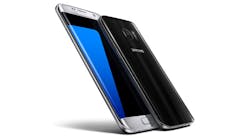After ending a two-year smartphone slide with the Galaxy S7, Samsung Electronics Co. could be about to hike capital spending to sustain a revival across the company.
At least $5 billion more of investment is headed to the display and semiconductor businesses, according to a survey of analyst estimates, to help Samsung ride out bumps in the phone market. Such a move reflects new optimism about the company after the success of the Galaxy S7, with the shares rallying 13% this year.
Samsung’s rise into an electronics behemoth has been fueled by the ability to get its memory chips and displays, often the most expensive components, into devices made by others. With the South Korean company said to be in talks to supply Apple Inc. with next-generation OLED screens and bring out its own phones with bendable screens, Samsung can use its cash pile of more than $60 billion to extend its lead on rivals.
“Samsung’s smartphone business has finally had a soft landing after a bumpy ride,” said Chung Chang Won, an analyst at Nomura Holdings Inc. in Seoul. Samsung will probably boost spending on memory and displays, which “are poised for a sudden rise as the next growth drivers.”
The shares slid 3.3% to close Wednesday at 1.42 million won ($1,222.41). Analysts however are betting they’ve got room to rise. Since the company’s last earnings report, the average target price of analysts has risen by 6.7%, backing the Galaxy S7’s ability to keep winning customers. In the same period, profit estimates have risen by almost half a billion dollars.
Samsung will report preliminary second-quarter earnings Thursday, with operating income expected to rise about 7% to 7.4 trillion won ($6.37 billion), according to the average estimate. Sales are projected to increase 4.9% to 50.9 trillion won ($43.82 billion).
But with growth in the global smartphone market evaporating, it needs to build up its other major businesses as competitors bring out new products in an attempt to spark growth.
“The mobile business is holding up well, but it’s still questionable whether this trend will be sustained over the coming quarters with more new devices in the pipeline from rivals,” said Lee Jae Yun, an analyst at Yuanta Securities Co.
The Korean technology giant hasn’t been afraid to make bold investments in advanced technologies and plants, even during a severe economic downturn. That has helped it outrun competitors in Japan and combat Chinese producers as it rose to the top of smartphones, chips and TVs.
Samsung had almost $23 billion of capital spending in 2015, the fourth straight year that capex topped $20 billion, according to data compiled by Bloomberg. The company said in April that it spent 4.6 trillion won ($3.96 billion) in the first quarter and annual spending could increase slightly.
OLED is one such example, with Samsung championing the screens as thinner, brighter and less taxing on the battery compared to liquid-crystal displays. By using the technology in its own Galaxy range, Samsung has become the biggest producer for mobile devices.
The company may introduce two new smartphones with bendable OLED screens as soon as next year, a move that could spark sales of components to rivals, people familiar with the matter said last month. Samsung has also held talks to be the exclusive supplier of displays for future iPhones, people familiar have said.
Delivering such products requires new plants, factory upgrades and equipment and the company may need to spend as much as 15 trillion won ($12.91 billion) just on OLED, according to HI Investment & Securities Co. But it’s got money in the bank: its hoard of cash and short-term investments has been growing steadily in past years, to more than 70 trillion won ($60.26 billion) at the end of March.
“To keep rivals off its turf, Samsung needs to move faster and go bold with investment now,” said Chung Won Suk, a Seoul-based analyst at HI Investment. “With Apple expected to join the race, the bendable display will eventually become the default feature on future smartphones.”
Samsung’s panel-making subsidiary Samsung Display Co. has already started to halt some of its older LCD lines to boost OLED capacity. Chung at HI Investment expects that to continue.
The popularity of the Galaxy S7 models, one with a curved display, is expected to have continued into the second quarter, helping to bail out its mobile division from a slump that has hit Apple and Chinese companies.
“Samsung’s business outlook seems extremely good and creates a lot of excitement now,” said Peter Yu, a Seoul-based analyst at BNP Paribas SA. “That is the opposite of what had been thought earlier this year.”
By Jungah Lee



